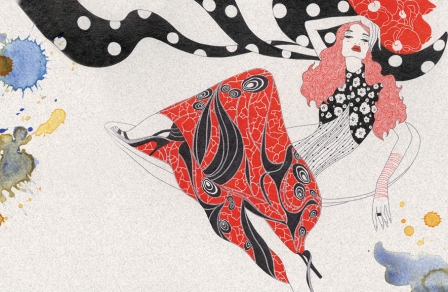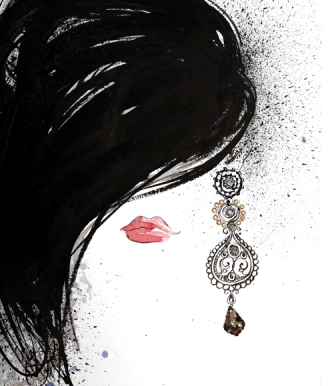Back in Vogue
March 01, 10
Costume jewelry may be regarded as “real” jewelry’s poor relation, but collectors and connoisseurs of the genre know there is nothing second best about it. When it comes to costume jewelry, no one knows the subject better than Carole Tanenbaum who has been in the vintage jewelry business for 25 years and has even published a book, Fabulous Fakes: A Passion for Vintage – 100 Years of Costume Jewelry, on the subject. Items from her collection have adorned some of
But perhaps the biggest name to wear pieces from the Carole Tanenbaum Vintage Collection is none other than a certain Mrs. O – Michelle Obama – who has a number of items, mainly brooches, from the collection. The First Lady even wore one of the brooches – a Victorian paste pin, once meant as a sash decoration – to her husband’s inauguration.
The definition of costume jewelry is that it is does not use any precious metals or stones. Rather than gold and diamonds, for example, it utilizes base metals, plastic and synthetic stones, essentially any practical material that was available at the time the piece was constructed. During World War 2, when all metal went to the war effort, Bakelite plastic was popularly used in jewelry design and it is a material that is seeing a current revival in popularity with modern designers.
| |
For Tanenbaum, however, it is not the materials used in the jewelry that makes it so special; rather it is the design, originality and quality of the piece. “A Picasso doesn’t sell for millions because of the materials used,” she jokes. “It sells for so much because it’s a Picasso.”
Although Tanenbaum is renowned as a vintage jewelry maven, she also buys diamond jewelry. “Although I buy real jewelry, I prefer to wear something from my vintage collection. It makes me feel intelligent rather than rich!”
Tanenbaum stresses that people, like herself, are not buying vintage and costume jewelry instead of diamond and gemstone jewelry but in addition to these types of pieces. “People really started buying costume jewelry along with gemstone jewelry in the past 10 years. Costume jewelry has been in vogue at Christie’s and Sotheby’s for many years now,” she says.
In light of the recent recession, the costume jewelry market has strengthened. The reason, Tanenbaum asserts is not because consumers buy costume jewelry at the expense of gemstone jewelry in an effort to economize, but rather because they are purchasing costume jewelry instead of buying new clothes. “In the current market, people would rather buy an accessory than another Armani suit so the recession has actually worked in [costume jewelry’s] favor. They are not buying because it is cheap rather than real, but because it is a more compromising answer to another new outfit.”
Since Tanenbaum began seriously collecting in 1996, she says prices have rocketed up. “A piece that cost $100 when I started collecting can cost as much as $1200 as dealer to purchase. The high-end has become almost unavailable to buy, and when it is available it is very costly.”
In comparison, she says, mass production pieces have not experienced the same price inflation. “Mediocrity doesn’t increase in the same way as one-off jewelry pieces; a situation that is the same in the gemstone jewelry market. A diamond tennis bracelet will never appreciate as much as a unique piece.”
The distinctiveness of costume jewelry is another reason why collecting it has become so popular. “It’s a unique way of accessorizing. The pieces are always conversational. If you put on a fabulous brooch, people will always comment on it. In addition, there’s a certain mystique to wearing an old piece that has been cherished through the decades.”
With a background in art, Tanenbaum looks to ever piece she considers purchasing as a work of art. “I’m very dictated by the wow factor. My point of view is a little outside the box. I like extraordinary design and imaginative color. There are certain pieces that I see that are great but I won’t have them in my personal collection because they don’t stimulate me.”
| |
It was when her personal collection got to big that Tanenbaum decided to offer her jewelry for sale. Today, she sells to department stores in the
Her collection is also available online at caroletanenbaum.com. While there is a large selection of non-precious materials, such as Bakelite, celluloid and wood, there is also plenty available for those who want their jewelry to be closer to “the real thing.” Recent offerings included a dangly pin of irregular cut topaz crystals, with green and amber rhinestones set in gold toned metal. The Austrian piece, dating from around 1950, was priced at $600. For brides-to-be there was a pair of shoulder duster earrings of openwork design, with large triangles dangling from pearl button tops. The circa 1950 pieces were signed by Tanenbaum’s favorite designer Henry Schreiner and were selling for $1,200. For a more modern fashion take, a 1970s collar necklace of billowing gold toned wire links was priced at $750.
Although the market for costume jewelry has spiraled in recent years, Tanenbaum says there are still many areas were prices are still accessible, and she is happy to offer pointers to budding collectors. One area she is looking to for the future is Bakelite-era wooden jewelry, especially figurative pins such as equestrian themes and comic book characters. “Copper jewelry has also not taken off yet. Designs from the 40s and 50s from Renoir Mattisse are very beautiful and tailored. They can compliment any decade and can be worn as current jewelry.” Prices for such jewelry starts at around $150, but you better snap it up fast; it won’t stay low for long.

